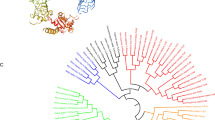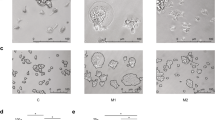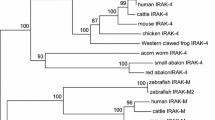Abstract
Myeloid differentiation factor 88 (MyD88) is an important adapter protein of the innate immune system, but it has never before been reported in yellow catfish (Pelteobagrus fulvidraco). In this study, we cloned and characterized the yellow catfish MyD88 gene. The gene was 1230 bp in length and contained an 876-bp open reading frame which encodes a polypeptide of 291 amino acid residues. The theoretical molecular mass and isoelectric point of this polypeptide were 33.4341 kDa and 5.17, respectively. Furthermore, bioinformatic and phylogenetic analyses grouped yellow catfish MyD88 with MyD88 of other fish. We found that the deduced amino acid sequence showed that the conserved N-terminal death domain and the C-terminal typical Toll/interleukin-1 receptor domain were very similar to those of other fish. Moreover, reverse transcription PCR showed that yellow catfish MyD88 is ubiquitously expressed in all tissues examined, with highest expression levels observed in the spleen and lowest levels in the intestine. Importantly, MyD88 was shown to be significantly up-regulated in the intestines after 30-day dietary supplement of Clostridium butyricum. Collectively, these results indicate that yellow catfish MyD88 has a conserved structure and is probably an important component of innate immunity in yellow catfish. This study is the first to identify and characterize MyD88 in yellow catfish, thereby providing a reference for further research into the yellow catfish innate immune system.







Similar content being viewed by others
References
Abolnik C (2015) Genomic and single nucleotide polymorphism analysis of infectious bronchitis coronavirus. Infect Genet Evolut J Mol Epidemiol Evolut Genet Infect Dis 32:416–424
Akira S (2003) Mammalian toll-like receptors. Asthma Immunol 15:5–11
Brownlie R, Allan B (2011) Avian toll-like receptors. Cell Tissue Res 343:121–130
Deguine J, Barton GM (2014) MyD88: a central player in innate immune signaling. F1000 Med Rep 6:97–97
Ezendam J, van Loveren H (2007) Immune effects of the probiotic Bifidobacterium breve. RIVM report 340320006. National Institute for Public Health and the Environment, Bilthoven, The Netherlands
Finn RD, Tate J, Mistry J et al (2000) The Pfam protein families database. Nucl Acid Res 32:263–266 (264)
Fischer H, Lutay N, Ragnarsdóttir B et al (2010) Pathogen specific, IRF3-dependent signaling and innate resistance to human kidney infection. Plos Pathog 6:8990–8995
Galdeano CM, Perdigón G (2006) The probiotic bacterium Lactobacillus casei induces activation of the gut mucosal immune system through innate immunity. Clin Vac Immunol 13:219–226
Gao Q, Qi L, Wu T et al (2012) Clostridium butyricum activates TLR2-mediated MyD88-independent signaling pathway in HT-29 cells. Mol Cell Biochem 361:31–37
Gasse P, Mary C, Guenon I et al (2007) IL-1R1/MyD88 signaling and the inflammasome are essential in pulmonary inflammation and fibrosis in mice. J Clin Investig 117:3786–3799
Goto A, Imler JL (2012) Toll signaling in flies and mammals: two sorts of MyD88. Immunity 36:555–557
Goyal AK, Garg T, Rath G (2016) Probiotics in human health. Forum Immunopathol Dis Ther 7(1):17–31. https://doi.org/10.1615/ForumImmunDisTher.018570
Hoshino K, Kaisho T, Iwabe T et al (2002) Differential involvement of IFN-β in Toll-like receptor-stimulated dendritic cell activation. Int Immunol 14:1225–1231
Hawlisch H, Köhl J (2006) Complement and toll-like receptors: key regulators of adaptive immune responses. Mol Immunol 43:13–21
Honda K, Taniguchi T (2006) IRFs: master regulators of signalling by toll-like receptors and cytosolic pattern-recognition receptors. Nat Rev Immunol 6:644–658
Horne WS, Price JL, Keck JL et al (2007) Helix bundle quaternary structure from α/β-peptide foldamers. J Am Chem Soc 129:4178–4180
Huffman JL, Brennan RG (2002) Prokaryotic transcription regulators: more than just the helix-turn-helix motif. Curr Opin Struct Biol 12:98–106
Ishibashi D, Atarashi R, Nishida N (2012) Protective role of MyD88-independent innate immune responses against prion infection. Prion 6:443–446
Janssens S, Beyaert R (2002) A universal role for MyD88 in TLR/IL-1R-mediated signaling. Trends Biochem Sci 27:474–482
Kelley JP, Hosoki K, Sur S (2016) MyD88-mediated innate immune response in a single cat dander extract challenge. J Allergy Clin Immunol 137:AB72–AB72
Kongchum P, Hallerman EM, Hulata G et al (2011) Molecular cloning, characterization and expression analysis of TLR9, MyD88 and TRAF6 genes in common carp (Cyprinus carpio). Fish Shellfish Immunol 30:361–371
Li C, Zienkiewicz J, Hawiger J (2005) Interactive sites in the MyD88 Toll/interleukin (IL) 1 receptor domain responsible for coupling to the IL1beta signaling pathway. J Biol Chem 280:26152–26159
Lin HL, Shiu YL, Chiu CS et al (2016) Screening probiotic candidates for a mixture of probiotics to enhance the growth performance, immunity, and disease resistance of Asian seabass, Lates calcarifer (Bloch), against Aeromonas hydrophila. Fish Shellfish Immunol 60:474–482
Livak KJ, Schmittgen TD (2001) Analysis of relative gene expression data using real-time quantitative PCR and the 2(-Delta Delta C(T)) Method. Methods 25:402–408
Loiarro M, Gallo G, Fantò N, Santis RD, Carminati P, Ruggiero V, Claudio S (2009) Identification of critical residues of the MyD88 death domain involved in the recruitment of downstream kinases. J Biol Chem 284:28093–28103
Meijer AH, Krens SFG, Medina Rodriguez IA et al (2004) Expression analysis of the toll-like receptor and TIR domain adaptor families of zebrafish. Mol Immunol 40:773–783
Mendoza-Barberá E, Corral-Rodríguez MA, Soares-Schanoski A et al (2009) Contribution of globular death domains and unstructured linkers to MyD88.IRAK-4 heterodimer formation: an explanation for the antagonistic activity of MyD88s. Biochem Biophys Res Commun 380:183–187
Neill LA (2003) The role of MyD88-like adapters in toll-like receptor signal transduction. Biochem Soc Trans 31:643–647
Neumann D, Kollewe C, Resch K et al (2007) The death domain of IRAK-1: an oligomerization domain mediating interactions with MyD88, Tollip, IRAK-1, and IRAK-4. Biochem Biophys Res Commun 354:1089–1094
Qian T, Wang K, Mu Y et al (2013) Molecular characterization and expression analysis of TLR 7 and TLR 8 homologs in large yellow croaker (Pseudosciaena crocea). Fish Shellfish Immunol 35:671–679
Sar van der AM, Stockhammer OW, Laan van der C et al (2006) MyD88 innate immune function in a zebrafish embryo infection model. Infect Immunity 74:2436–2441
Siednienko J, Gajanayake T, Fitzgerald KA et al (2011a) Absence of MyD88 results in enhanced TLR3-dependent phosphorylation of IRF3 and increased IFN-β and RANTES production. J Immunol 186:2514–2522
Siednienko J, Gajanayake T, Fitzgerald KA et al (2011b) Absence of MyD88 results in enhanced TLR3-dependent phosphorylation of IRF3 and increased IFN-β and RANTES production. J Immunol (Baltimore MD 1950) 186:2514–2522
Sun M, Chen QH, Zhang WN et al (2011) Study on microencapsulation of Clostridium butyricum. Animal Husbandry Feed Sci 36:263–273
Takano T, Kondo H, Hirono I et al (2006) Identification and characterization of a myeloid differentiation factor 88 (MyD88) cDNA and gene in Japanese flounder, Paralichthys olivaceus. Dev Comp Immunol 30:807–816
Tran NT, Liu H, Wang WM (2015) Blunt snout bream (Megalobrama amblycephala) MyD88 and TRAF6: characterisation, comparative homology modelling and expression. Int J Mol Sci 16:7077–7097
Wang JQ, Jeelall YS, Ferguson LL et al (2014) Toll-like receptors and cancer: MYD88 mutation and inflammation. Front Immunol 5:367
Warner N, Nunez G (2013) MyD88: a critical adaptor protein in innate immunity signal transduction. J Immunol 190:3–4
Wesche H, Henzel WJ, Shillinglaw W et al (1997) MyD88: an adapter that recruits IRAK to the IL-1 receptor complex. Immunity 7:837–847
Whang I, Lee Y, Kim H et al (2011) Characterization and expression analysis of the myeloid differentiation factor 88 (MyD88) in rock bream Oplegnathus fasciatus. Mol Biol Rep 38:3911–3920
Yan LI, Tuo-Ping LI, Sun YY (2013) Clostridium butyricum and its application in agricultural production. Acad Period Farm Product Process 17:019
Yao C, Luan K, Peng W, Yong Z et al (2009) Molecular cloning and expression of MyD88 in large yellow croaker, Pseudosciaena crocea. Fish Shellfish Immunol 26:249–255
Zhou X, Tian Z, Wang Y et al (2010) Effect of treatment with probiotics as water additives on tilapia (Oreochromis niloticus) growth performance and immune response. Fish Physiol Biochem 74:501–509
Zhu Y, Qiu X, Ding Q et al (2014) Combined effects of dietary phytase and organic acid on growth and phosphorus utilization of juvenile yellow catfish Pelteobagrus fulvidraco. Aquaculture 430:1–8
Zhu Y, Ding Q, Chan J et al (2015) The effects of concurrent supplementation of dietary phytase, citric acid and vitamin D3 on growth and mineral utilization in juvenile yellow catfish Pelteobagrus fulvidraco. Aquaculture 436:143–150
Acknowledgements
This work was supported by the National Natural Science Foundation of China (No. 31402083) and the Fundamental Research Funds of China West Normal University (No. 17E077).
Author information
Authors and Affiliations
Corresponding authors
Ethics declarations
Conflict of interest
The authors declare no competing financial interests.
Rights and permissions
About this article
Cite this article
Yu, L., Zhang, L., Yang, H. et al. Identification and characterization of the myeloid differentiation factor 88 gene in yellow catfish. 3 Biotech 8, 430 (2018). https://doi.org/10.1007/s13205-018-1448-z
Received:
Accepted:
Published:
DOI: https://doi.org/10.1007/s13205-018-1448-z




